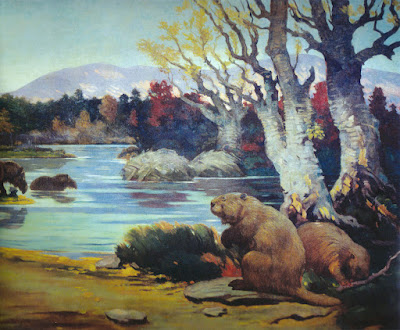Did you know there were once giant beavers roaming the Hudson Valley region?
Bear-sized giant beavers (Castoroides ohioensis) lived during the Pleistocene Epoch (the time of the most recent ice age) and grew to over 7 feet in length with a weight of over 200 pounds. As their scientific name implies, they were first discovered in Ohio (1837) but extended from the upper Midwest and Canada over to the east coast (another species - Castoroides dilophidus - existed in the southeastern U.S.).
Giant beavers did exist in the Hudson Valley. One, for example, was discovered (along with caribou and flat-headed peccary fossils) at the Dutchess Quarry Cave site near Middletown in Orange County (near where a lot of mastodons have also been discovered). At this site, the beaver radiocarbon dated to 11,670 +/-70 years before present.
Castoroides ohioensis skeleton in the Field Museum, Chicago
Here's an artist's conception by the famous early 20th century illustrator Charles R. Knight.
The giant beaver differed from modern beavers in that they probably had rounded tails and not the flattened ones seen today and also in their teeth. Their teeth were much longer (up to 6 inches) and were ridged unlike the smooth teeth of modern beavers. These ridges would have strengthened their teeth and their jaw structure suggests that they would have had a strong biting force. It's hard to say if they constructed dams and lodges as beavers do today and stable isotope evidence from their bones indicates a mostly aquatic plant diet. Their large teeth were likely better adapted to digging in pond muck than in cutting trees.
Giant beavers first appear in the fossil record near the start of the Pleistocene ice age almost 2 million years ago and died out around 11,000 years ago as the North American climate was warming and glaciers had retreated north. The end of their time also overlapped with the migration of paleo-Indians into eastern North America. Did they die off due to climate change or did humans kill them off? This is the perennial question of all the Pleistocene megafauna which vanished around the same time.
While there is no direct evidence these early Native Americans hunted giant beavers (although it seems unlikely they would not have utilized all food source animals) some of the tribes have stories and legends that seem to be about them (it's amazing to think about oral traditions lasting thousands of years). They feature in an eastern Cree creation story and in tales by the Chippewa, Seneca, and other tribes (see, for example,
https://www.jstor.org/stable/481746).
The Hudson Valley was a very different place just a few thousand years ago!





Hello Steve, I'm currently reading your book (it was serendipitously recommended to me on Kindle). I'm a recovering "young earth creationist" (my homeschool high school science curriculum was based on Ken Ham/Answers in Genesis - enough said!). I somehow got through an AS, BS, and Master's degree while totally faking an understanding of the natural sciences, so I'm currently self-studying to try and catch up on all the stuff I missed. Being a Dutchess County resident, your book is really making geology come alive by tying it into all of the places I live near (and I appreciate the references to YEC discourse sprinkled in! I recognized the "Were you there?" quote immediately). I haven't finished it yet (I'll be sure to rate & submit a book review when I do) but I had to let you know how much I'm enjoying your book. Keep up the great work.
ReplyDeleteThanks for the nice comments.
ReplyDelete